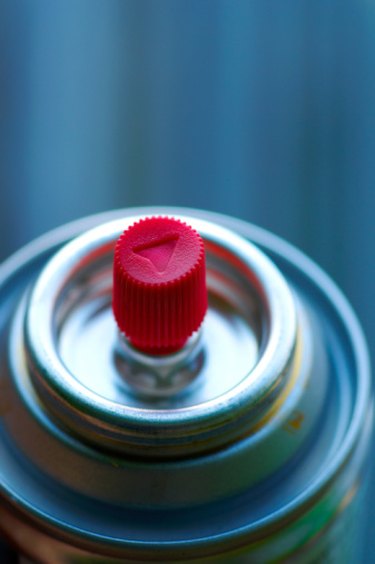There may be a time in your life when you will have the need to restore faded vinyl color. This is common for boat seats, vehicle dashboards, furniture, luggage, car door panels, vinyl car tops and floor mats. You could always go the route of re-upholstering the vinyl, but repainting it works as long as the vinyl is in good structural shape, with no holes or tears, and the spray paint is specifically design for vinyl.

Video of the Day
Things You'll Need
Specialty Vinyl Spray Paint
Painter'S Drop-Cloth
Sponge
5-Gallon Bucket
Mild Detergent
Tack-Cloth
Blue Painter'S Tape
Lint-Free Towel
Step 1
Remove the synthetic leather or vinyl object to be restored from the vehicle, boat or home. Remove the entire item, not the vinyl or synthetic leather covering itself.
Video of the Day
Step 2
Remove any additional items from the object to be painted that you do not want to paint, such as switches, trim, knobs, screws, metal pieces, etc.
Step 3
Place your vinyl or synthetic leather object to be re-painted and restored in a well-ventilated, dust-free area, such as an open garage or workshop. Place the object on top of a drop cloth. Drape the drop cloth to catch any over-spray.
Step 4
Clean all of the vinyl or synthetic leather surfaces. Mix a solution of 3/4 cup mild detergent to four parts of water in the 5-gallon bucket. Use a sponge and thoroughly clean all of the surface area that you will be painting.
Step 5
Rinse all of the soap residue off of your vinyl or synthetic leather object to paint and let it dry. Use a dry, lint-free towel to help remove any excess water.
Step 6
Allow the object to be painted to dry for at least two to three hours.
Step 7
Use blue painter's tape and tape over anything you do not want to get painted or objects that you could not remove.
Step 8
Gently dust over your object to be painted to with your tack cloth to remove any small dust particles.
Step 9
Shake the can vigorously for about a minute to get the marble inside to rattle. Hold the can 10 to 12 inches from the surface of the object and spray on a thin first coat in a steady, back-and-forth motion. Slightly overlap each stroke, and always keep your can the same distance from the object throughout the entire application of paint. Keep the first layer thin, almost transparent, so that there are no drips and no runs. If you get drips or runs, clean the nozzle tip, move further away from the object you are painting, and immediately wipe the drips and runs off with your towel.
Step 10
Allow at least 15 to 30 minutes of time to dry. Apply at least three to five more light coats until you can no longer see the original faded color and there is a uniform new color on the object.
Tip
Paint in temperatures between 50 degrees Fahrenheit and 90 degrees Fahrenheit with a humidity below 85 percent to ensure proper drying. Do not paint in windy, dusty conditions.
Apply a vinyl or synthetic leather protector once you are done painting.
Consult the paint can for drying times before use to ensure that no paint rubs off on clothing.